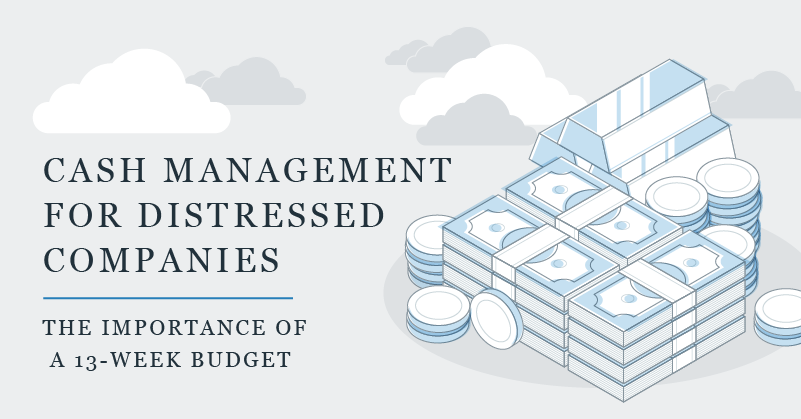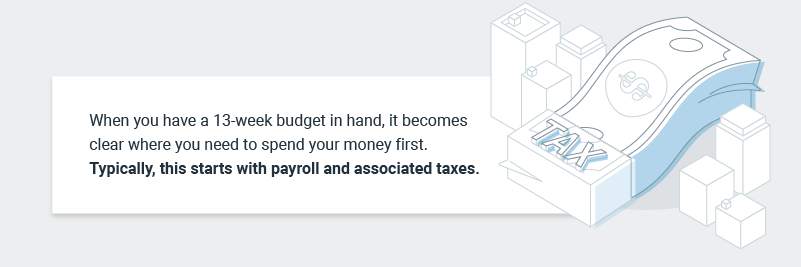
No matter what type of business distress a company may be experiencing, a liquidity challenge is one of the most likely results. In particular, the COVID-19 pandemic has underscored the importance of having cash on hand. According to a report from the Association for Financial Professionals, 72% of survey respondents noted that “pandemic planning and contingencies” influenced the organization’s decision to elevate cash holdings.
When faced with business distress, companies of all sizes could find themselves experiencing challenges with cash management. In a recent small business survey from QuickBooks, 60% of the companies studied said that cash flow was an issue.
Struggling with cash management can lead to a host of consequences, including difficulty paying bills, obtaining loans, buying goods and even meeting payroll. With such widespread challenges stemming from liquidity issues, businesses need to come up with a plan.
Thankfully, creating, maintaining and continuously improving a 13-week budget can support your efforts to address some of these concerns, helping to keep your business afloat or providing essential support during a bankruptcy. We’ll explore what 13-week budgets are and discuss why they can be so beneficial.
The basics of 13-week budgets
For many distressed companies, a 13-week budget is a standard tool for helping mitigate issues associated with liquidity, allowing them to manage their cash reserves more effectively.
A 13-week cycle equates to roughly three months or just over 90 days. A period of this length is typically considered long enough for all relevant stakeholders to acquire a deep understanding of the current operating cycle. On the other hand, 13 weeks is usually short enough for the business to focus more exclusively on near-term concerns. Other time frames, like six-month or annual projections, tend to be better suited for long-range targets. When liquidity is an issue, you need to pay closer attention to correcting course in the coming days, weeks and months.
Budgets based on the 13-week model are also usually centered on cash flowing into and out of the business, not operating margins. When a company creates a 13-week budget, the primary goal is to carry cash forward every week so the business can avoid going negative. With a forward-looking plan that emphasizes this kind of weekly progress, the company can attempt to get ahead of situations that would potentially result in bank overdrafts, implementing corrective measures in advance.
Benefits and applications of the 13-week budget
As a widely recognized tool for managing financial distress, 13-week budgets carry a great deal of value. In particular, they can support your efforts to establish a priority structure for where you spend cash while offering assurance to third parties and providing assistance as you seek to improve your financial posture for long-term stability.
Prioritizing your obligations with a 13-week budget
When you have a 13-week budget in hand, it becomes clear where you need to spend your money first. Typically, this starts with payroll and associated taxes. The next tier would be for essential payments that uplift the business. For example, purchasing new, saleable inventory — instead of settling past-due inventory purchases — will put your business in a stronger position. After selling the inventory, you may be able to roll some cash forward, working your way closer to improved liquidity.

While compiling this budget, you’ll often find that capital expenses, prepayments, advertising and other costs — such as those that are less essential or that take longer to provide a return on investment — will fall to the bottom of the list.
Generating a 13-week budget can help you inspire more confidence in your company’s senior leadership among secured creditors. They may grow to understand that your business is performing sufficiently for them to continue lending to the company.
Ideally, your budget will reveal a cushion that grows over time and does not recede. This occurs when your liquid assets, such as inventory and accounts receivable, continue to reliably exceed the amount owed by the business. A strong cushion will be attractive to lenders that are providing you with asset-based loan facilities, meaning any kind of credit backed by working capital assets.
Providing assurances with the 13-week budget
When leveraged successfully, a 13-week budget may be a useful tool for helping some companies to improve their cash flow management to the extent that filing for bankruptcy is not necessary.
However, that’s not always the case. For businesses that are involved in bankruptcy, a 13-week budget is no longer just a strategy for navigating financially tumultuous situations. Instead, it becomes a requirement.
Just as the budget can help instill creditors with confidence in the business’s financial planning outside of bankruptcy, the same document can provide a greater level of credibility for companies that are currently going through bankruptcy.
The 13-week budget may also become part of the court record, serving as a public document required for certain filings. The business will be expected to continually redo and perform against these documents throughout the bankruptcy process.
Using the 13-week budget as a tool for monitoring continuous improvement
The most effective way to employ a 13-week budget is to strive for continuous improvement. This is true regardless of whether the business is in Chapter 11 or simply attempting to improve its financial standing while experiencing liquidity issues.
Financial experts have to learn from the budget by regularly monitoring progress against targets and finding a way to drive improvements. Ideally, the finance team should complete weekly budget-to-actual reports where the group compares previous projections with real, verified outcomes. With this information in hand, the team can identify and seek explanations to the noted variances, and analyze the implications of that information.
Over time, the finance department will be able to compare the organization’s current budgets to cumulative data, allowing them to refine the process further.
If your business is experiencing problems with cash management, contact the restructuring services team at CFGI to find out how we can assist.

